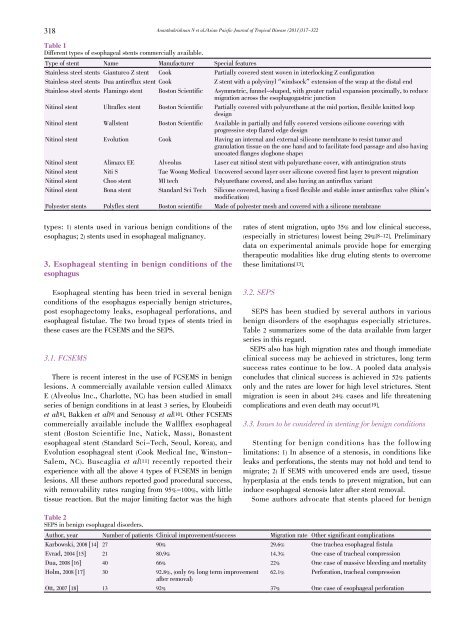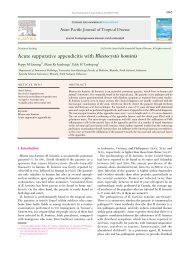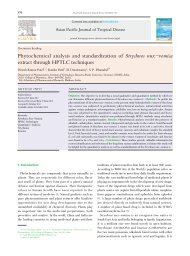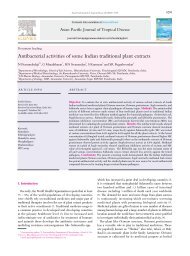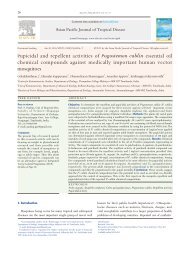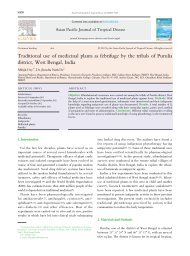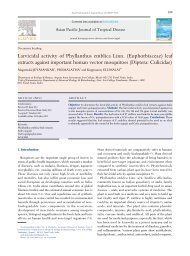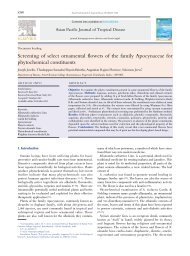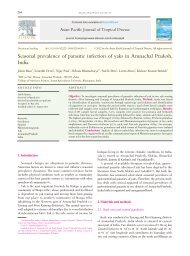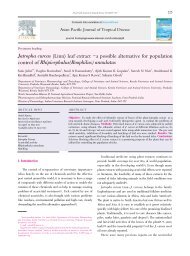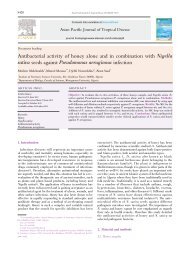Esophageal stents in benign and malignant diseases - Asian Pacific ...
Esophageal stents in benign and malignant diseases - Asian Pacific ...
Esophageal stents in benign and malignant diseases - Asian Pacific ...
You also want an ePaper? Increase the reach of your titles
YUMPU automatically turns print PDFs into web optimized ePapers that Google loves.
318<br />
Table 1<br />
Different types of esophageal <strong>stents</strong> commercially available.<br />
types: 1) <strong>stents</strong> used <strong>in</strong> various <strong>benign</strong> conditions of the<br />
esophagus; 2) <strong>stents</strong> used <strong>in</strong> esophageal malignancy.<br />
3. <strong>Esophageal</strong> stent<strong>in</strong>g <strong>in</strong> <strong>benign</strong> conditions of the<br />
esophagus<br />
<strong>Esophageal</strong> stent<strong>in</strong>g has been tried <strong>in</strong> several <strong>benign</strong><br />
conditions of the esophagus especially <strong>benign</strong> strictures,<br />
post esophagectomy leaks, esophageal perforations, <strong>and</strong><br />
esophageal fistulae. The two broad types of <strong>stents</strong> tried <strong>in</strong><br />
these cases are the FCSEMS <strong>and</strong> the SEPS.<br />
3.1. FCSEMS<br />
There is recent <strong>in</strong>terest <strong>in</strong> the use of FCSEMS <strong>in</strong> <strong>benign</strong><br />
lesions. A commercially available version called Alimaxx<br />
E (Alveolus Inc., Charlotte, NC) has been studied <strong>in</strong> small<br />
series of <strong>benign</strong> conditions <strong>in</strong> at least 3 series, by Eloubeidi<br />
et al[8], Bakken et al[9] <strong>and</strong> Senousy et al[10]. Other FCSEMS<br />
commercially available <strong>in</strong>clude the Wallflex esophageal<br />
stent (Boston Scientific Inc, Natick, Mass), Bonastent<br />
esophageal stent (St<strong>and</strong>ard Sci-Tech, Seoul, Korea), <strong>and</strong><br />
Evolution esophageal stent (Cook Medical Inc, W<strong>in</strong>ston-<br />
Salem, NC). Buscaglia et al[11] recently reported their<br />
experience with all the above 4 types of FCSEMS <strong>in</strong> <strong>benign</strong><br />
lesions. All these authors reported good procedural success,<br />
with removability rates rang<strong>in</strong>g from 95%-100%, with little<br />
tissue reaction. But the major limit<strong>in</strong>g factor was the high<br />
Ananthakrishnan N et al./<strong>Asian</strong> Paicfic Journal of Tropical Disease (2011)317-322<br />
Type of stent Name Manufacturer Special features<br />
Sta<strong>in</strong>less steel <strong>stents</strong> Gianturco Z stent Cook Partially covered stent woven <strong>in</strong> <strong>in</strong>terlock<strong>in</strong>g Z configuration<br />
Sta<strong>in</strong>less steel <strong>stents</strong> Dua antireflux stent Cook Z stent with a polyv<strong>in</strong>yl “w<strong>in</strong>dsock” extension of the wrap at the distal end<br />
Sta<strong>in</strong>less steel <strong>stents</strong> Flam<strong>in</strong>go stent Boston Scientific Asymmetric, funnel-shaped, with greater radial expansion proximally, to reduce<br />
migration across the esophagogastric junction<br />
Nit<strong>in</strong>ol stent Ultraflex stent Boston Scientific Partially covered with polyurethane at the mid portion, flexible knitted loop<br />
design<br />
Nit<strong>in</strong>ol stent Wallstent Boston Scientific Available <strong>in</strong> partially <strong>and</strong> fully covered versions (silicone cover<strong>in</strong>g) with<br />
progressive step flared edge design<br />
Nit<strong>in</strong>ol stent Evolution Cook Hav<strong>in</strong>g an <strong>in</strong>ternal <strong>and</strong> external silicone membrane to resist tumor <strong>and</strong><br />
granulation tissue on the one h<strong>and</strong> <strong>and</strong> to facilitate food passage <strong>and</strong> also hav<strong>in</strong>g<br />
uncoated flanges (dogbone shape)<br />
Nit<strong>in</strong>ol stent Alimaxx EE Alveolus Laser cut nit<strong>in</strong>ol stent with polyurethane cover, with antimigration struts<br />
Nit<strong>in</strong>ol stent Niti S Tae Woong Medical Uncovered second layer over silicone covered first layer to prevent migration<br />
Nit<strong>in</strong>ol stent Choo stent MI tech Polyurethane covered, <strong>and</strong> also hav<strong>in</strong>g an antireflux variant<br />
Nit<strong>in</strong>ol stent Bona stent St<strong>and</strong>ard Sci Tech Silicone covered, hav<strong>in</strong>g a fixed flexible <strong>and</strong> stable <strong>in</strong>ner antireflux valve (Shim’s<br />
modification)<br />
Polyester <strong>stents</strong> Polyflex stent Boston scientific Made of polyester mesh <strong>and</strong> covered with a silicone membrane<br />
Table 2<br />
SEPS <strong>in</strong> <strong>benign</strong> esophageal disorders.<br />
rates of stent migration, upto 35% <strong>and</strong> low cl<strong>in</strong>ical success,<br />
(especially <strong>in</strong> strictures) lowest be<strong>in</strong>g 29% [8-12]. Prelim<strong>in</strong>ary<br />
data on experimental animals provide hope for emerg<strong>in</strong>g<br />
therapeutic modalities like drug elut<strong>in</strong>g <strong>stents</strong> to overcome<br />
these limitations[13].<br />
3.2. SEPS<br />
SEPS has been studied by several authors <strong>in</strong> various<br />
<strong>benign</strong> disorders of the esophagus especially strictures.<br />
Table 2 summarizes some of the data available from larger<br />
series <strong>in</strong> this regard.<br />
SEPS also has high migration rates <strong>and</strong> though immediate<br />
cl<strong>in</strong>ical success may be achieved <strong>in</strong> strictures, long term<br />
success rates cont<strong>in</strong>ue to be low. A pooled data analysis<br />
concludes that cl<strong>in</strong>ical success is achieved <strong>in</strong> 52% patients<br />
only <strong>and</strong> the rates are lower for high level strictures. Stent<br />
migration is seen <strong>in</strong> about 24% cases <strong>and</strong> life threaten<strong>in</strong>g<br />
complications <strong>and</strong> even death may occur[19].<br />
3.3. Issues to be considered <strong>in</strong> stent<strong>in</strong>g for <strong>benign</strong> conditions<br />
Stent<strong>in</strong>g for <strong>benign</strong> conditions has the follow<strong>in</strong>g<br />
limitations: 1) In absence of a stenosis, <strong>in</strong> conditions like<br />
leaks <strong>and</strong> perforations, the <strong>stents</strong> may not hold <strong>and</strong> tend to<br />
migrate; 2) If SEMS with uncovered ends are used, tissue<br />
hyperplasia at the ends tends to prevent migration, but can<br />
<strong>in</strong>duce esophageal stenosis later after stent removal.<br />
Some authors advocate that <strong>stents</strong> placed for <strong>benign</strong><br />
Author, year Number of patients Cl<strong>in</strong>ical improvement/success Migration rate Other significant complications<br />
Karbowski, 2008 [14] 27 90% 29.6% One trachea esophageal fistula<br />
Evrad, 2004 [15] 21 80.9% 14.3% One case of tracheal compression<br />
Dua, 2008 [16] 40 66% 22% One case of massive bleed<strong>in</strong>g <strong>and</strong> mortality<br />
Holm, 2008 [17] 30 92.8%, (only 6% long term improvement<br />
after removal)<br />
62.1% Perforation, tracheal compression<br />
Ott, 2007 [18] 13 92% 37% One case of esophageal perforation


